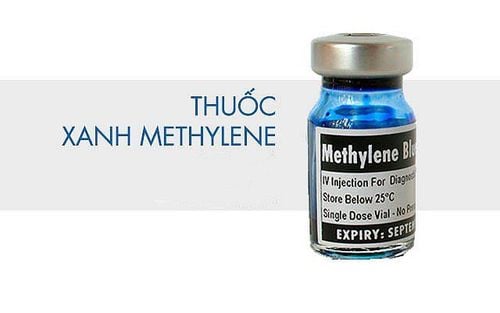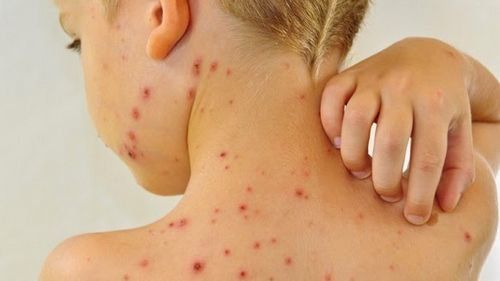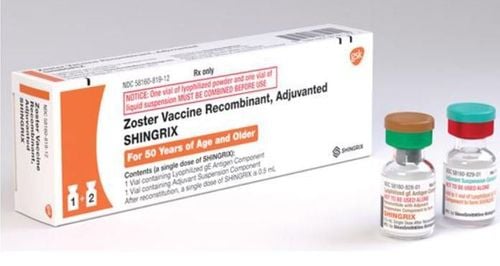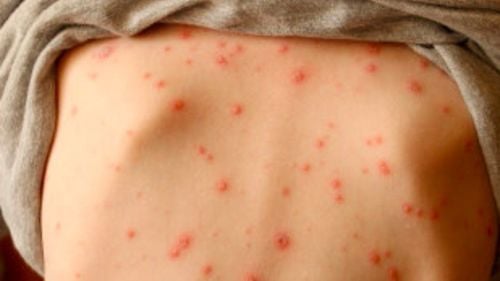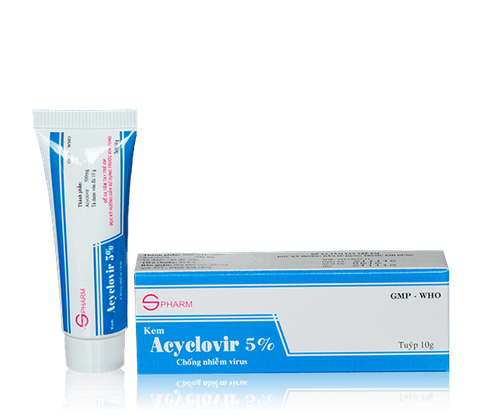This is an automatically translated article.
The article was consulted professionally with BS. Nguyen Hai Ha - Head of Vaccine Unit - Pediatric Outpatient Department - Pediatric Center - Vinmec Times City International Hospital.Chickenpox is an infectious disease caused by a virus that has the potential to become an epidemic. The disease has a benign nature, is often monitored and treated at home, but can also cause life-threatening complications, especially for children. How to take care of a child with chickenpox to avoid complications?
1. General information about chickenpox
Chickenpox (chickenpox) is caused by a virus called Varicella Zoster, usually appears in late winter, early spring and lasts into summer, common in children under 10 years old, can become epidemic in kindergartens and schools. The disease is spread through the respiratory tract by contact with the virus through saliva, nasal secretions or fluid from broken blisters. The disease usually presents with the following symptoms:Onset: As with other viral infections, the patient may present with fever, headache, muscle pain, in some cases, children with may have no warning symptoms. When the disease develops: The patient's body will appear "chicken blisters" - a blistering rash. These nodules are characterized by small round nodules that appear quickly within 12-24 hours, these will progress to blisters, blisters, clear fluid, often itchy, can grow all over the body or grow scattered on the body, the average number is about 100 - 500 nodules. Under normal circumstances these blisters dry up, become scabs and clear up on their own in 4-5 days. In case of superinfection, blisters will be cloudy, yellow... The blisters contain viruses, so when they come into contact with the fluid in this nodule, they will infect healthy people. In children, chickenpox usually lasts about 5 to 10 days leading to school absences.
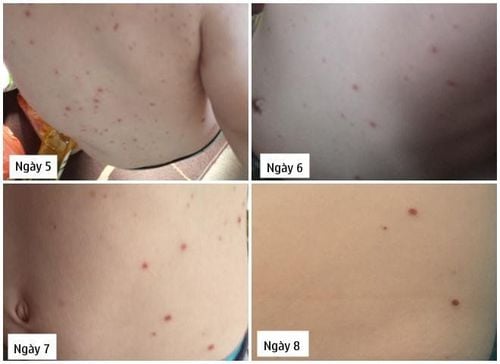
2. How to take care of a child with chickenpox
When children with chickenpox need to be detected early, isolated to avoid spreading and need proper care to avoid complications of the disease. The disease is usually benign but sometimes causes dangerous complications such as meningitis, hemorrhage, sepsis, chickenpox infection, cellulitis, hepatitis,... even death. Therefore, in order to effectively treat children with chickenpox, it needs to be combined with the right care regimen. Here are some notes when taking care of children with chickenpox:Because it is a disease that can be transmitted through the respiratory tract and by direct contact with blister fluid, when a child has chickenpox, the first thing the family should do Keep the child at home until completely cured. Children need to lie in a separate, well-ventilated room with sunlight. The isolation period is about 7 to 10 days from the onset of the disease (rash) until the blisters are completely dry. In case anyone in contact with a child with chickenpox must wear a mask to avoid infection. Hands should be washed with soap or an antiseptic solution before and after caring for children. Especially pregnant women should absolutely avoid contact with sick people. Keep your child's hands clean. For young children, it is recommended to cut their nails, keep their nails clean or use cloth gloves to wrap their hands to avoid complications of secondary skin infections caused by scratching and scratching the blisters. Change clothes and bathe daily with clean warm water. Wear loose, light, thin clothing. Wear soft, absorbent clothes and pay special attention to ensuring the baby's skin hygiene to avoid complications. Children should use their own personal items: towels, cups, cups, bowls, chopsticks. Give your child easy-to-digest liquid foods, supplement foods rich in vitamin C, and drink plenty of water. Clean the nasopharyngeal area daily for children with 0.9% physiological saline solution. Note to let the burn burn itself, avoid breaking the burn because it will leave a scar and be susceptible to bacterial superinfection. Use a solution of Milian blue (Methylene blue) to dab on broken blisters.
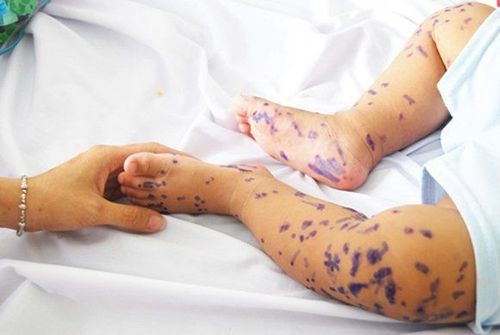
3. What should children with chickenpox avoid?
Some foods to abstain from chickenpox:Fatty foods, foods that are too nutritious Hot spicy foods such as spices such as ginger, garlic, chili, pepper, cinnamon... Goat meat, dog meat, chicken, geese, seafood Hot fruit such as plum, peach, litchi, longan...
4. Chickenpox Prevention
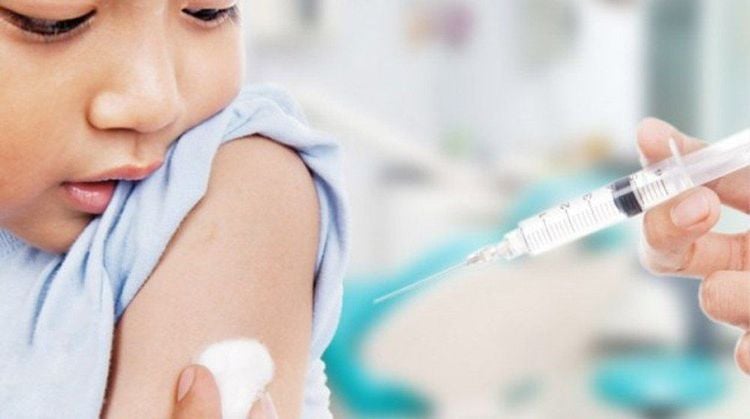
The most optimal is to actively prevent the disease by vaccinating children and adults who are not immune to chickenpox, especially women who want to prepare for pregnancy. Chickenpox should be vaccinated against chickenpox because if you get chickenpox during pregnancy, your baby can be born with birth defects.
Currently, there is a vaccine against chickenpox, which is given very early when children are 9 months old or older, so children should be proactively vaccinated to avoid infection during chickenpox epidemics. In Vietnam, there are a number of vaccines against chickenpox such as: Varicella (Korea), Varivax (MSD-USA), Varilrix (GSK-Belgium) with the following injection regimen:
Varilrix: inject from 9 months of age and older, with 2 doses at least 6 weeks apart. Varivax: injection from 12 months of age and older. For children from 12 months old to under 13 years old: the prescribing information is a single dose, but given the epidemic situation in Vietnam, 2 doses should be given to better protect the child. According to the company's research, the second dose can be at least 3 months apart from the first dose, but according to CDC, WHO can give a second dose when children are 5-6 years old, that is, about 4 years apart from the first dose to increase effectiveness. preventive fruit. For children 13 years of age and older: 2 doses 4-8 weeks apart. Varicella: injection from 12 months of age and older For children from 12 months to under 13 years: the prescribing information is a single dose, but according to CDC, WHO, a second dose can be given when the child is 5-6 years old, ie, about 4 years from dose 1 to increase the effectiveness of disease prevention. For children 13 years and older: 2 doses 6-8 weeks apart. Vinmec International General Hospital system is a reputable vaccination facility to vaccinate against diseases including chickenpox vaccine. With many advantages as follows:
Before vaccination, all customers are pre-screened with specialist doctors to ensure the best health when vaccinated. The doctor will advise the family on age-appropriate preventive vaccines according to the latest recommendations of the Ministry of Health & World Health Organization as well as how to monitor the reaction after vaccination. A team of experienced, professional doctors and nurses who understand young psychology helps families feel secure during the vaccination process. 100% of vaccinated customers are monitored and re-evaluated before leaving. Post-vaccination monitoring room is fully equipped with emergency facilities; the team of doctors - nurses are trained in anaphylaxis emergency management to ensure timely and correct treatment when an incident occurs. In addition, Vinmec Hospital system always has an emergency team ready to coordinate with the vaccination room to handle cases of anaphylaxis, respiratory failure - circulatory arrest to ensure that customers are vaccinated safely. best. The vaccination room is airy, with a play area, helping children feel comfortable as if they are walking and have a good mentality before and after vaccination. Vaccines are imported and stored in a modern cold storage system, with a cold chain meeting GSP standards, with a refrigerator containing the vaccine at each injection room being a dedicated refrigerator. can ensure a temperature of +2 degrees Celsius to +8 degrees Celsius when the power is out within 24 hours, in order to keep the vaccine in the best condition to ensure quality. Currently, Vinmec is building software that can check injection history, send reminders to parents/customers so that parents/customers don't forget their vaccination schedule via computer or phone conveniently. Vaccination information will be synchronized with the national immunization information system.
Please dial HOTLINE for more information or register for an appointment HERE. Download MyVinmec app to make appointments faster and to manage your bookings easily.





